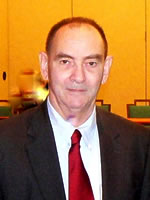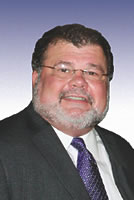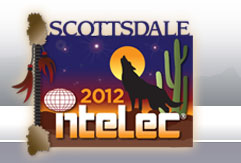

 |
 |
|
|
||||||||||||||||
| Table of contents | ||||||||||||||||
|
||||||||||||||||
| Contents | Next-> | ||||||||||||||||
|
||||||||||||||||
|
|||||||||||||
|
APEC 2012 Shatters Attendance Record As Growth |
|||||||||||||
Attendance at APEC has been growing year-on-year since 2009. This year, our attendance figures exceeded 3,000 for the first time – easily breaking that barrier with over 3,400 engineers in attendance! Members of the global power electronics community come to APEC in growing numbers because they expect to find the highest quality presentations and world-class exhibit. And APEC has once again delivered. Here are some of the milestones that Frank Cirolia reported for APEC 2012:
Siamak Abedinpour, this year’s Program Chair, now takes over the reins as General Chair for APEC 2013. As we bask in the glow of a job well-done, work is already underway to make APEC 2013 even bigger, even better. APEC moves back to the West Coast next year, convening in Long Beach, CA March 17-21, 2013. Early indications are that we may break 200 exhibitors for the first time!
As a final note, we wish to acknowledge the efforts and tireless dedication of Don Woodard, who after many, many years as Exhibits Chair is stepping down. Thanks Don for all you have done and will continue to do for APEC and PSMA.
|
|||||||||||||
|
|||||||||||||||||||||||||||||||||||||
|
PSMA 2012 Annual Meeting Attracts |
|||||||||||||||||||||||||||||||||||||
|
A buffet breakfast was served at 7:30 a.m. and provided an opportunity for networking and meeting colleagues. Outgoing Chairman Dusty Becker opened the meeting by welcoming all the attendees and asked each to briefly introduce themselves. Among those present were many of the 30 student recipients of the APEC Attendance Awards. This is the first year the awards were provided jointly by IAS, PELS and PSMA and attracted applicants from 37 different schools in 8 countries.
The first item on the agenda was the election of four people to the Board of Directors. The following candidates were elected to the Board of Directors for the three-year term (2012-2015):
Dusty introduced Carl Blake as the new Chairman for the term 2012-2014 and also introduced the other Executive Officers who will serve for the next two years:
Before giving his report, Carl presented Dusty with a plaque to acknowledge his leadership and contributions to the Association. Carl Blake discussed his vision for the coming year which is to expand the participation of member companies as a means to increase the value of membership. He encouraged every company representatives to promote the activities of PSMA to others in their company and inform them of the opportunities provided by each of the PSMA Technical Committees, especially the Power Technology Roadmap activities in the coming year.
Following the Chairman’s Report was a financial Report from Michel Grenon and individual reports from the PSMA Committees. Frank Cirolia, General Chairman for APEC 2012, reported that there were over 3,400 attendees – a new record! There were also a record number of exhibitor booths. APEC 2012 should be successful from both a technical and financial viewpoint Siamak Abedinpour, who will be the General Chair for APEC 2013, reported that plans for that conference are underway and he is looking forward to another successful APEC. The invited speaker at this year’s Annual Meeting was Brian Patterson, Chairman of EMerge Alliance. He explained what the Emerge Alliance is; who the members are and what they hope to accomplish. The purpose of the Alliance is to define new power platforms for improved economics, reliability and ecology. The membership represents all key industry stakeholders. Standards are created, vetted, voted on and used by member organizations. Brian Patterson’s presentation also included information about Net Zero Energy Buildings – buildings that produce as much energy as they consume.
The minutes from the PSMA Annual Meeting will be posted in the Members Only area of the PSMA web site together with the charts from all of the presentations. Most of the PSMA Technical Committees held meetings during APEC 2012 to set their program for the upcoming year. The Saturday prior to the start of APEC 2012, the Power Technology Committee co-chaired by Eric Persson and Aung Tu held an organizing and planning meeting for the next Technology Roadmap, which will be available prior to APEC 2013. The dinner for APEC Sponsors was held as usual on Sunday evening. Since this was also the night of Super Bowl XLVI, the formal dinner was replaced by a lively Super Bowl party.
The Annual Meeting, PSMA Committee meetings, as well as the technical sessions, seminars, Industry Presentations, exhibits and other events kept PSMA members busy all the week. The APEC banquet, held at Harry Potter’s World, in Universal Studios, was a chance for everyone to relax and enjoy themselves.
The PSMA Hospitality Suite was held again this year to introduce the Association to people from member companies who wanted to learn more about PSMA and to inform non-members about the benefits of membership. |
|||||||||||||||||||||||||||||||||||||
|
||||||||
|
|
||||||||
|
 Ed Herbert has been an active participant in PSMA for several years and currently serves as co-chair of the Magnetic Committee and co-chair of the Energy Efficiency Committee. Ed received a BEEE from Yale University in 1963 and worked as a design engineer, a project engineer, an engineering supervisor, then as engineering manager until 1985. Since then, he has been independent, promoting his patented technologies for license. Most recently, Ed was instrumental in rejuvenating the Capacitor Committee and as Co-Chair of the Magnetics Committee was the sponsor of the Pilot Project and the Phase II Project at Dartmouth, studying core loss. He also prepared a Supplemental Report further analyzing the data. Ed is also active in the Alternative Energy Committee and Capacitor Committee. He has supported the past two Power Technology Roadmap reports and served as a group leader on the committee. In running for Director, Ed stated “I have been enriched by my association with PSMA. I welcome the opportunity to give more in return.” Provided by Ed Herbert, Independent Inventor  Don Woodard was elected to Board of Directors of the Power Sources Manufacturers Association in 2012 after serving on the APEC Conference Committee since 2002. His eight-year tenure as the organization’s Exhibits Chairman saw exceptional growth in both vendor participation and conference attendance. Don has also served as the Eastern USA Manager for the FMC Corporation. He is known for his proven leadership and active commitment to advancing the standards, collective direction and corporate responsibility within the Power industry. Don is president of Venable Instruments, which was founded in 1979 by H. Dean Venable, the pioneer of stability analysis. Don spent 25 years working in the private sector before entering the Power industry in 1999. His executive management and sales and marketing background contribute a unique perspective to his role on the PSMA Board. Don graduated from North Texas State University (now the University of North Texas) in 1976 with a degree in business administration. A native of east Texas, Don and his wife of 27 years, Melony, have called Austin home since 1995. They are parents to two adult children, Jerad and Maegan, and recently became grandparents to Vivienne. The Woodards are active members of Lake Hills Church and serve on several committees and outreach programs, such as Mobile Loaves and Fishes. In his spare time, Don enjoys fly fishing, bird hunting, and all things rock and roll. In the next issue of the Update we will introduce you to Michel Grenon, who was elected as a Director at the Annual Meeting. Michel also serves as Secretary/Treasurer. Carl Blake, Chairman of the Board, was elected to his second term at that meeting. Carl was profiled in the previous issue of the Update. Provided by Don Woodard, President, Venable Instruments |
||||||||
|
|||||||||
 About Our Members |
|||||||||
|
 Würth Elektronik has worldwide presence through the technical sales force and provides customer support on product designs from concept to manufacture. Their product range contains EMC ferrites, filter chokes, common mode chokes, circuit protection EMI shielding material, power inductors, power transformers, LAN and telecom transformers, RF inductors, LTCC components, connectors, switches, assembly technique and power elements.
All catalogue items are available ex-stock and samples orders will be delivered within 24 to 48 hours and entirely free of charge! Their products are fully RoHS & REACh compliant. Würth Elektronik has 4,800 employees and a turnover in 2010 of 202 Million Euro. As part of the Wurth Group, a family run and privately owned company employing some 65,000 staff globally with a turnover of $11 billion, you can rely on our motto “More Than You Expect”. Würth Elektronik offers more, such as sample kits with continuous free re-fills, EMC lab support, seminars, technical design books and much more! Visit us at www.we-online.com. Provided by Benjamin Benchimol, Editors Note: We would like to feature your company in a future issue of the Update. |
|||||||||
|
||||||||||
|
Welcome to PSMA | ||||||||||
| ||||||||||
|
Aerolearn
Current Solutions
GaN Systems Inc.
NextEnergy
SL Power Electronics
Venture-Q, LLC
|
||||||||||
|
||||||||||
The California Energy |
||||||||||
|
The CEC is a highly proactive agency and follows the wishes of people of California, a progressive state. In this way, the CEC wields significant regulatory power because California is a large and significant market, and its energy-related regulations are forward looking. However, even though the US DOE has not always followed CEC's recommendations and in some instances some serious legal challenges have been made to CEC's regulatory positions by various entities. But its power and influence cannot be underestimated. The California Energy Commission (CEC) was created in 1974 as an agency within the Natural Resources Agency. Initially the charter was to certify construction or modification of any electric plant by looking into its need and the suitability. Later as energy infrastructure development diversified to include nuclear, renewable (solar) and other forms of power generating technologies, CEC charter changed accordingly. Besides focusing on the power generating side of the business, CEC has also ventured into regulating efficiency standards for various home appliances and buildings. The CEC recently passed a new regulation related to energy efficiency guidelines for mobile chargers: on January 12th, 2012, CEC voted 3-0 to have stringent regulations related to battery chargers that power mobile phones, tablet computers, power tools and many other portable equipment. It is estimated that the market in California uses about 170 million battery chargers which waste as much as 60% of energy in either standby mode when the equipment is not being charged or when it is fully charged..." The CEC's sphere of influence is expanding and its rise in prestige and action can be attributed to one man, its former commissioner, Dr. Arthur Rosenfeld. He is one of the most revered individuals in the field of energy efficiency and widely acknowledged as "The Father of Energy Efficiency". Dr. Rosenfeld served as the commissioner of the CEC from 2000 to 2010, an entire decade. During this time, CEC tackled issues related to power generation, transportation and efficient use of energy. Efficient use of energy became as important as producing it, without using polluting and carbon-creating fossil fuel-based power generation. Dr. Arthur Rosenfeld was instrumental in promoting energy efficiency as one of the important issues in the energy infrastructure. "Rosenfeld" is now used as a unit to measure energy savings, created in the honor of Arthur Rosenfeld. Currently, Dr. Arthur H Rosenfeld is a member of the U.S. Department of Energy Secretary Steven Chu's Energy Advisory Board. CEC wields significant clout in setting various energy goals for California. For example, it was the CEC that established its Renewable Portfolio Standard (RPS) program with a goal to increase power generated from the renewable sources to 20% by 2017. It is advisable for any power supply company, located anywhere in the world, to monitor and follow the regulatory stance of the CEC related to energy efficiency, because the regulation has a tendency to migrate towards the entire US and then into the global energy infrastructure.
The views expressed in this article are solely of Mohan Mankikar. They do not represent the views of PSMA. Mohan Mankikar has been a part of the power supply industry for over twenty five years. An active member of the PSMA since its founding, he had been a board member of the PSMA and currently serves on the Advisory Council. |
||||||||||
|
||||||||
|
Debunking Solar |
||||||||
Misconceptions About Solar System Metrics Could
|
||||||||
|
||||||||
|
INTELEC® 2012, Conference |
||||||||
 INTELEC©, the International Telecommunications Energy Conference, is the annual world-class technical forum which presents the latest developments in communications energy systems and related power-processing devices and circuits. This Conference, which serves the broad community of researchers, suppliers and operators, explores new technologies of power conversion, energy storage and systems for telecom applications and environment. For more information on INTELEC please see www.intelec.org INTELEC 2012 will feature a technical exhibition. If you manufacture, distribute, sell or service products related to telecommunications or computer energy systems the INTELEC 2012 exhibit is the place for you. You will have the opportunity to engage with decision makers and engineers in areas such as, advanced energy storage systems and technologies, DC systems for central office and outside plant, green power solutions, energy efficiency, powering through disasters and many others that are critical to operational success. INTELEC 2012 is introducing two new avenues for technical communications.
The conference program will include key note and plenary sessions, technical presentations, workshops and poster sessions. Manuscripts of accepted papers will be included in the conference proceedings. The tutorial program will include several sessions on Batteries, Energy, and Power Systems for Communications. An extensive social program will include two exhibit receptions, afternoon tour, banquet and a comprehensive partner program.
For information including Call for Papers brochure, Patron Opportunities and Exhibitor Information please go to http://www.intelec.org/intelec2012/ Provided by Donovan Davidson,
|
||||||||
|
||||||||||
Solar Energy Stock Index: |
||||||||||
|
The Solar Energy Stock Index Report, published by their Renewable Energy team each quarter, provides you with information on the following:
|
||||||||||
|
||||||||||
Lincoln International's Solar Energy DealReader: |
||||||||||
|
||||||||||
|
||||||||||
EMS Stock Index: |
||||||||||
|
||||||||||
|
||||||||||
Lincoln International's EMS DealReader: |
||||||||||
This data is included with the permission of Lincoln International. For more information, you may contact John McManus (jmcman@optonline.net) or the Association Office.
|
||||||||||
|
||||||||||||||||||||||||||||||||||||||
PSMA Special Call |
||||||||||||||||||||||||||||||||||||||
APEC 2013Twenty-eighth Annual March 17- 21, 2013 Long Beach Convention Center Long Beach, CA USA
Papers of value to the practicing engineer are solicited in the following topic areas:
(Please see the APEC 2013 website for a more detailed description by subtopic.) The following PSMA Committee Chairs may be contacted to provide guidance to prospective Authors in the preparation of their abstracts and papers:
The Association Office will provide contact information on request.
Prospective authors are asked to submit a digest explaining the problem that will be addressed by the paper, the major results, and how this is different from the closest existing literature. Papers presented at APEC must be original material and not have been previously presented or published. The principal criteria in selecting digests will be the usefulness of the work to the practicing power electronic professional. Reviewers value evidence of completed experimental work. Authors should obtain any necessary company and governmental clearance prior to submission of digests. The material must be must be submitted in electronic format to the APEC office no later than July 9, 2012. Notification that a paper was accepted or declined will be provided Please visit www.apec-conf.org for additional instructions. For more information regarding this Special Call for Papers, contact the Association Office at 973-543-9660 or power@psma.com. Calls for Special Presentations, Professional Education Seminars, and Exhibitor Seminars will be posted at www.apec-conf.org.
|
||||||||||||||||||||||||||||||||||||||
|
|||||||||||||||||||||||||||||||||||||
|
Events of Interest - Mark Your Calendar |
|||||||||||||||||||||||||||||||||||||
|
|||||||||||||||||||||||||||||||||||||
| <<-Contents | <-Previous | Page 14 | | |||||||||||||||||||||||||||||||||||||
|
If you or anyone in your company is interested in getting on the distribution list for future issues of PSMA UPDATE, please send e-mail to: power@psma.com. Be sure to include your name and
|
|||||||||||||||||||||||||||||||||||||